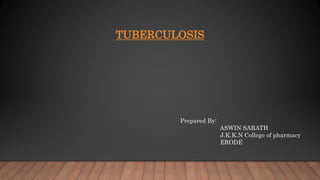
Tuberculosis
- 1. TUBERCULOSIS Prepared By: ASWIN SARATH J.K.K.N College of pharmacy ERODE
- 2. TUBERCULOSIS DEFINITION: • Tuberculosis is defined as a highly contagious disease caused by the bacterium called Mycobacterium. • TB is more common in people with immune system problems , such as AIDS, than in general population.
- 3. AETIOLOGY It is caused by tubercle bacilli, which belong to the genus Mycobacterium. Mycobacterium species include: M. tuberculosis M. bovis M. africanum INCUBATION PERIOD The incubation period from infection to demonstrable primary lesion or significant tuberculin reaction ranges from 2-10 weeks. Latent infection may persist for lifetime.
- 4. TYPES Latent TB: This refers to the condition when a person has TB infection but the bacteria remains inactive in the body and causes no symptoms. Latent TB is not contagious but has a chance of becoming active. Active TB: This refers to the condition when TB bacteria multiply in the body and develop symptoms of TB. If the lungs are infected the infection can be spread easily.
- 5. TRANSMISSION: Transmission occur through exposure to tubercle bacilli in air borne droplet nuclei produced in people with pulmonary or respiratory tract TB during expiratory efforts such as coughing or sneezing. In general, only respiratory forms of TB are infectious. FACTORS INCREASING RISK OF ACTIVE TB: o HIV positive o Injecting drug users o Solid organ transplantation o CKD or receiving haemodialysis o Receiving anti-TNF alpha treatment o Silicosis
- 6. DRUG RESISTANT TB: MDR-TB It is caused by bacteria that are resistant to at least isoniazid and rifampicin, the most effective anti-TB drugs. MDR-TB results from either primary infection with resistant bacteria or may develop in course of a patient’s treatment. XDR-TB It is a form of TB caused by bacteria that are resistant to isoniazid and rifampicin, that is, MDR-TB, as well as any fluroquinolone and any of the second line anti-TB injectable drugs including amikacin, kanamycin or capreomycin (WHO,2010).
- 7. DIAGNOSIS: Symptoms: Cough for 3 weeks or more Sputum usually mucopurulent or purulent Haemoptysis not always a feature Fever may be associated with night sweats Tiredness Weight loss Malaise CLINICAL DIAGNOSIS Microbiological: Direct microscopy of sputum is the simplest and quickest method by looking for acid-fast bacilli. A minimum of 3 sample one of which should be early morning should be collected.
- 8. TUBERCULLIN TESTING It is used to detect latent TB. The standard test consist of an intradermal injection Of 2TU of Stanens Serum Institute (SSI) tuberculin RT23 in 0.1 ml solution for injection. The results are read 48-72hrs later. A diameter of induration of less than 6mm is negative. An induration of between 6 and 15mm may be due to previous TB infection or BCG vaccination. An induration of more than 15mm is strongly suggestive of TB infection or disease. CHEST RADIOGRAPHY Cavitation may be seen , the incidence can vary between 10% and 30%.
- 9. DRUG CLASSIFICATION: First line drugs Second line drugs Isoniazid Rifampicin Pyrazinamide Ethambutol Streptomycin Fluoroquinolones Other oral drugs Injectable drugs Ofloxacin Levofloxacin Moxifloxacin Ciprofloxacin Ethionamide Prothionamide Cycloserine Terizidone Paraamino- salicylic acid Rifabutin Thiacetazone Kanamycin Amikacin Capreomycin ANTITUBERCULAR DRUGS
- 10. TREATMENT: The recommended standard treatment regimen for respiratory and most other forms of TB are: Rifampicin, Isoniazid, Pyrazinamide, and Ethambutol for the initial 2 months (initial phase). A further 4 months of Rifampicin and Isoniazid (continuation phase). A longer period of treatment than the standard 6 month is needed for meningeal TB and where there is direct spinal cord involvement. DOTS (Directly observed therapy) : The treatment of a TB infected patient in the direct observation of a physician or nurse.
- 11. Pregnancy: Standard therapy should be given , although streptomycin should not be used as it may be ototoxic to fetus. Renal disease: Patients with renal disease may be given AKT-4 as these drugs are predominantly eliminated by non-renal routes. Ethambutol undergo extensive renal elimination and therefore dose reduction is needed. Liver disease: Monitoring of liver enzymes is recommended in patients with liver failure or alcoholics because rifampicin, isoniazid and pyrazinamide are all potentially hepatotoxic. TREATMENT OF TB IN SPECIAL CIRCUMSTANCES: TB in children: Ethambutol should not routinely be used in young children who could be unable to report visual disturbances.
- 12. MECHANISM OF ACTION a) ISONIAZID (INH) INH Reactive metabolite Forms adduct with NADP Inhibit DHF R’ase Forms adduct with NAD Inhibit DNA Inhibit InhA and KasA synthesis Inhibit mycolic acid synthesis Inhibit cell wall synthesis Catalase peroxide
- 13. b) RIFAMPICIN Rifampicin interrupts RNA synthesis by binding to beta subunit of mycobacterial DNA- dependent RNA polymerase.( encoded by rpoB gene), the mammalian RNA polymerase does not bind to rifampicin. c) PYRAZINAMIDE It is chemically similar to INH, it is converted to an active metabolite pyrazinoic acid encoded by pncA gene .This get accumulated in acidic medium and inhibit mycolic acid synthesis. d) ETHAMBUTOL Ethambutol inhibits arabinosyl transferases (encoded by embAB gene) involved in arabinogalactan synthesis thereby interfering with mycolic acid incorporation in cell wall.
- 14. ADVERSE REACTION: Rifampicin: It is usually well tolerated. Gastro-intestinal upset, fever and rash can occur. It will colour the urine orange-red with approximately 4 h of a dose. Isoniazid: Fever, skin rashes and dose dependent peripheral neuropathy. Peripheral neuropathy is probably due to depletion of vit. B6 , hence pyridoxine supplementation at a dose of 10-25mg/day is given. Pyrazinamide: Can cause hepatitis. Ethambutol: Ocular toxicity is the most important side effect.
- 15. Inhalation of droplet infected with M.tuberculoisis Enters the upper airways Primary defense mechanism gets activated Mucus producing goblet cells and cilia tries to push the microorganism out ( but fails) M . tuberculosis enters the alveoli Alveolar macrophages engulf the microorganism (phagocytosis) PATHOPHYSIOLOGY
- 16. Primary infection After three weeks: Cell mediated immunity gets activated Granuloma Tissue necrosis Cavitation
